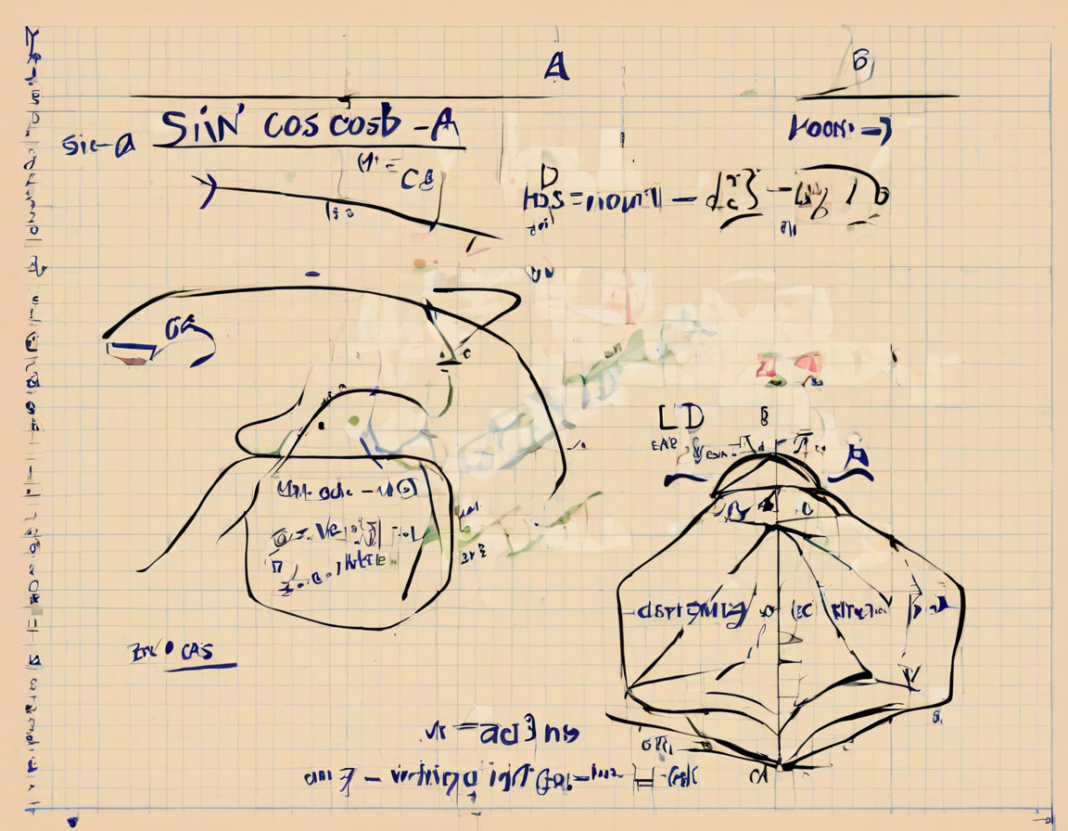Trigonometry, the branch of mathematics that deals with the relationships between the sides and angles of triangles, is a fundamental concept in both mathematics and physics. The sine (sin) and cosine (cos) functions are essential components of trigonometry, used to relate the angles of a right triangle to the lengths of its sides. Understanding the relationship between the sine and cosine functions can help simplify calculations and solve complex trigonometric equations. In this article, we will explore the simplified formula for the relationships between sin A cos B, where A and B are angles in a triangle.
Understanding Sin and Cos Functions
Before we dive into the formula for sin A cos B relations, let’s refresh our understanding of the sine and cosine functions. In a right triangle, the sine of an angle is defined as the ratio of the length of the side opposite that angle to the length of the hypotenuse. Mathematically, it is expressed as:
[ \sin A = \frac{{\text{Opposite Side}}}{{\text{Hypotenuse}}} ]
Similarly, the cosine of an angle is defined as the ratio of the length of the adjacent side to the length of the hypotenuse:
[ \cos A = \frac{{\text{Adjacent Side}}}{{\text{Hypotenuse}}} ]
The Formula: sin A cos B relations
The relationship between sin A and cos B can be expressed using a trigonometric identity known as the product-to-sum formula. The product-to-sum formula for sin A cos B is given by:
[ \sin A \cos B = \frac{{1}}{{2}} \left( \sin (A + B) + \sin (A – B) \right) ]
By using this formula, we can simplify the calculations involving the product of sine and cosine functions of different angles. Let’s break down the formula further to understand how it is derived and how it can be applied in trigonometric problems.
Deriving the Formula
The product-to-sum formula for sin A cos B can be derived using the trigonometric addition formulas for sine and cosine. The sine addition formula states that:
[ \sin (A + B) = \sin A \cos B + \cos A \sin B ]
Similarly, the cosine addition formula is given by:
[ \cos (A + B) = \cos A \cos B – \sin A \sin B ]
By rearranging the terms in the sine addition formula, we can solve for (\sin A \cos B) to obtain:
[ \sin A \cos B = \frac{{1}}{{2}} \left( \sin (A + B) – \sin (A – B) \right) ]
Applying the Formula
The product-to-sum formula for sin A cos B provides a convenient way to simplify trigonometric expressions involving the product of sine and cosine functions. By utilizing this formula, we can convert products of sine and cosine terms into sums of sine functions of the sum and difference of the angles.
For example, suppose we need to evaluate (\sin 30^\circ \cos 60^\circ). We can use the formula to rewrite this expression as:
[ \sin 30^\circ \cos 60^\circ = \frac{{1}}{{2}} \left( \sin (30^\circ + 60^\circ) + \sin (30^\circ – 60^\circ) \right) ]
Solving the above expression, we get:
[ \sin 30^\circ \cos 60^\circ = \frac{{1}}{{2}} \left( \sin 90^\circ + \sin (-30^\circ) \right) ]
Using the properties of the sine function, we find that (\sin 90^\circ = 1) and (\sin (-30^\circ) = -\frac{1}{2}), which gives us:
[ \sin 30^\circ \cos 60^\circ = \frac{{1}}{{2}}(1 – \frac{1}{2}) = \frac{{1}}{{4}} ]
Further Simplifications and Identities
In addition to the product-to-sum formula for sin A cos B, there are several other trigonometric identities that can be useful in simplifying trigonometric expressions. These identities include the Pythagorean identities, double angle identities, and half-angle identities, among others.
- Pythagorean Identities:
- (\sin^2 A + \cos^2 A = 1)
- (\tan^2 A + 1 = \sec^2 A)
-
(1 + \cot^2 A = \csc^2 A)
-
Double Angle Identities:
- (\sin 2A = 2 \sin A \cos A)
- (\cos 2A = \cos^2 A – \sin^2 A)
-
(\tan 2A = \frac{2\tan A}{1 – \tan^2 A})
-
Half-Angle Identities:
- (\sin^2 \frac{A}{2} = \frac{1 – \cos A}{2})
- (\cos^2 \frac{A}{2} = \frac{1 + \cos A}{2})
- (\tan \frac{A}{2} = \frac{1 – \cos A}{\sin A})
These identities, along with the product-to-sum formula for sin A cos B, provide tools to simplify complex trigonometric expressions and solve trigonometric equations effectively.
Frequently Asked Questions (FAQs)
- What is the product-to-sum formula for sin A cos B?
-
The product-to-sum formula for sin A cos B is given by (\sin A \cos B = \frac{1}{2} \left( \sin (A + B) + \sin (A – B) \right)).
-
How can I apply the sin A cos B formula in trigonometry problems?
-
The formula can be used to simplify calculations involving the product of sine and cosine functions of different angles by converting them into sums of sine functions of the sum and difference of the angles.
-
Are there other trigonometric identities that can help simplify calculations?
-
Yes, there are several trigonometric identities such as Pythagorean identities, double angle identities, and half-angle identities that can be utilized to simplify trigonometric expressions.
-
Can the product-to-sum formula be extended to other trigonometric functions?
-
While the formula specifically relates to the product of sine and cosine functions, similar product-to-sum formulas exist for other trigonometric functions like sine and sine, cosine and cosine, or sine and tangent.
-
How does understanding trigonometric identities benefit mathematical problem-solving?
- Grasping trigonometric identities enables one to simplify complex equations, prove trigonometric relationships, and solve mathematical and physics problems efficiently.
In conclusion, the product-to-sum formula for sin A cos B relations is a valuable tool in trigonometry for simplifying calculations involving the product of sine and cosine functions. Understanding this formula, along with other trigonometric identities, can enhance your problem-solving skills and mathematical proficiency. Remember to practice applying these formulas in various trigonometric scenarios to solidify your understanding and mastery of trigonometry.
